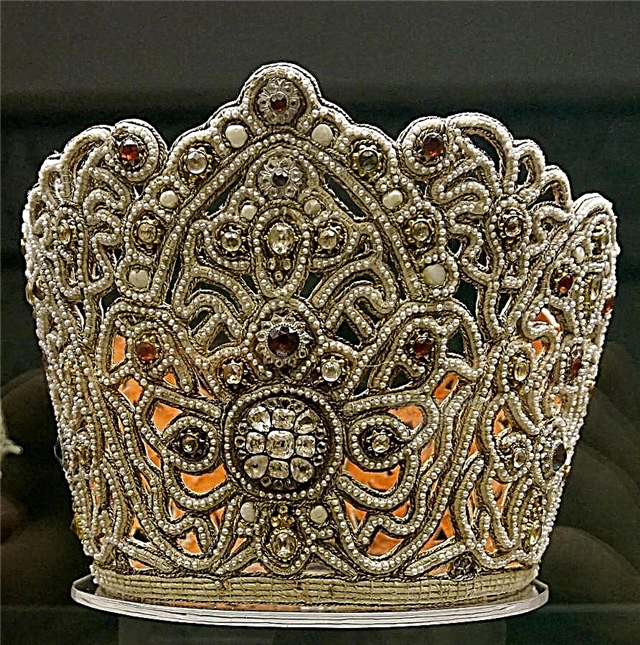From ancient times, Russian craftswomen were famous for the art of pearl embroidery. We invite you to go on a fascinating historical journey with us!

Today, with the word "pearls", we primarily recall the Coco Chanel pearl beads, the laconic pearl string in the Grace Kelly style, the noble carnations that the fashion gloss so often recommends as a perfect complement to the evening look. And we rarely remember (or even don’t know at all!) That embroidery with pearls in Russia was an unusually popular type of needlework, in which Russian craftswomen reached unprecedented heights!
Pearl scattering: decorate the rim with velvet and beads
Pearl sewing: rivers and seas
 Workshops of the Kremlin, 1672−1673
Workshops of the Kremlin, 1672−1673 The first mention of pearls in Russia is found in ancient Russian chronicles. For example, in the Ipatiev Chronicle, one of the oldest Russian annalistic vaults, it is mentioned that in the fire of 1185 many items embroidered with gold and pearls burned in Vladimir. In those ancient times, local river pearls were used, and in the future, domestic extraction of this gemstone was striking in scale: more than 150 rivers supplied pearls, from the Volga to the Pearl Stream and the basin of Lake Onega and Zaonezhie. But over time, sea pearls became one of the most important articles of Russian imports, so in the XVII century. A member of the Swedish diplomatic mission to Moscow, the author of the description of the Russian kingdom, Johann Philipp Kilburger wrote with sincere surprise: "Pearls were used in Russia more than in all of Europe."
Our northern rivers were so rich in pearls that the state was literally unable to control the production, and - no matter how incredible it may sound! - luxurious, fully embroidered with pearls holiday dresses could afford even ordinary peasant women. Traveler Baron August von Hacksthausen in his notes gives us a very accurate idea of the prevalence of pearls in the peasant environment of some provinces, for example, Nizhny Novgorod, where "every peasant woman wears from 200 to 300, and sometimes up to 1000 real pearls on her headdress" !
 Podolnik feloni, Workshops of the Kremlin, XVII century
Podolnik feloni, Workshops of the Kremlin, XVII century Such a luxury is explained very simply: it was the peasants who were engaged in the extraction of river pearls, so inevitably a significant part of it, albeit not of the highest quality, settled in families.
Pearl Game: DIY Necklace
Types of pearls and its preparation
Despite the abundance of pearls, its value varied greatly and depended, of course, on size and color. Yellowish pearls were not honored, therefore, for example, imported from China was not popular, but snow-white or delicately tinted stone was considered the most valuable. The shape was also of great importance: pearls of regular round shape were called “round” or “pitched”, and pearls of irregularly oblong shape that had growths were called differently, for example, “ugly”, “toothy” or “horned”.

Before use, pearls were processed in several stages. Pearls that are just removed from the shells do not harden immediately and may harden in quality when hardened. Therefore, he was subjected to the so-called "pickling." So this process is described in old books about catching pearls: “Industrialists, seeing the grain, tear it from the meat and put it in their mouth, which they hold for two hours and this is called“ pickling. ”After that, the pearls in a wet rag are kept in the bosom, until it will not harden completely. "Hardened pearls are often additionally cleaned and ground using, in the worst case, emery, and in the best, real diamond, and this work was called “diamond pearls”. Then, with the help of drills of various sizes, holes were drilled in the pearls (sometimes with a thickness in a human hair!), But it is also known that pearls that were not yet hardened for embroidery could simply be pierced with a thin needle. At the final stage, the pearls were sorted by size: small, medium, large.
DIY pearl collar
Pearl embroidery: female art
 Princess Yusupova Zinaida Nikolaevna. Outfit for the ball. 1903
Princess Yusupova Zinaida Nikolaevna. Outfit for the ball. 1903 Sewing with pearls, otherwise called "lowering", "fathom", was considered the prerogative of women, in contrast, for example, from the lace business, in which laced men were common. The fame of Russian craftswomen rattled even outside the country! “In sewing,” wrote the Swedish nobleman Peter, “they are skilled and skilled in such a way that they surpass many embroiderers with pearls and their work was exported to distant lands.”
The demand for needlewomen was so high that workshops began to appear everywhere, not only at monasteries, but also secular, the so-called "luminaries." Known works of the luminaries of the princes Staritsky, the boyars of Godunov, the "trading guests" of the Stroganovs and many others.
 Instructions, Workshops of the Kremlin, 1672−1673
Instructions, Workshops of the Kremlin, 1672−1673 Often the hostess of the house headed such a luminary - the noblewoman, the princess, the queen, who, as a rule, was herself a skilled craftswoman. The staff of needlewomen was staffed depending on the consistency of the head of the house and sometimes reached hundreds, while the wives and daughters of servicemen were engaged in embroidery in the rooms of high-ranking gentlemen, and simple peasants worked in houses more simply.
Techniques and techniques
 XII century Novgorod State United Museum-Reserve
XII century Novgorod State United Museum-Reserve The earliest examples of pearl sewing techniques that have come down to us are the 12th-century handbags stored in the Novgorod Museum. The bottom is made by small pearls laid directly on a fabric without flooring, the so-called "fencing pearls". Starting from the 15th century, as a rule, pearls are sewn not on fabric, but on a flooring made of either a white cord in one or two rows, or of white threads, “white”. So, in fact, the technique is called - white planting.
The advantages of just such a technique are obvious: if the base fabric wore out, sewing could be cut out and transferred to a new background, and if stones were torn off from separate sections, the pattern, due to the flooring, did not break and was easily restored.
When planting, pearls scattered on black velvet are first strung with a needle on a long white strong linen or silk thread. Pearl thread is usually laid out in a pattern and is attached with a cross stitch with another thread, while the stitch is made behind each individual stone.

Often, pearl embroidery was adjacent to gold embroidery, for example, sheathed on both sides with a cord of 6-7 gold threads twisted together. In addition, a variety of materials, sparkles, and other precious stones were used.
 Sakkos, Kremlin Workshops, 1696
Sakkos, Kremlin Workshops, 1696 An interesting fact: all the samples of ancient sewing, which were carried out on the hoop (regardless of technique), were lubricated on the back with a paste welded on kvass to prevent work from shrinking when removing from the hoop! In this case, the glue was applied directly by hand from the back of the sewing, and sometimes, in particular in large works, the entire wrong side was smeared.
Pearl sewing techniques are very diverse and inventive, so those who would like to study them today in all their diversity and subtleties will have to not only snoop over books, but also go to study in a profile workshop!
“My sweet pearls are sweet on your chest! ...” I.A. Bunin, 1901
 Armouries
Armouries Pearl sewing can be divided into two major areas: secular and church.From a religious point of view, pearls were directly associated with purity, purity and holiness, so it was not only widely used in decorating church vestments and creating icons, but was even depicted in frescoes as decoration of the clothes of angels and saints.
 Instructions, the second half of the XVII century.
Instructions, the second half of the XVII century. In the XVI century, the art of sewing with pearls begins to actively develop and unfold in all its diversity - first of all, in the luxurious clothes of the sovereign and his entourage. Hans Kobenzl, the ambassador of Emperor Maximilian II, described the mantle of Ivan the Terrible, completely covered with diamonds, rubies, fools and other precious stones and pearls the size of a nut! And this is just one of many, many other testimonies of foreign guests, struck by the grandeur of decoration and royal attire. Not only holiday clothes were embroidered with pearls, but also the upper, for example, fur coats and raincoats, hats, caftans, handrails, even shoes!
 Boot, second half of the 17th century, Armory
Boot, second half of the 17th century, Armory In the second half of the 17th century, pearl embroidery reached its true heyday: compositions became more complicated, techniques and techniques were perfected and amazing inventiveness. Both male and female clothes were equally embroidered with pearls: flyers, soul-makers, and little girls, but especially abundantly pearl sewing was presented on the women's headdresses - kicks, kokoshniks, girl’s bangs, dressings, coruna, crowns, embroideries, etc. These are sewn pearls and precious stones, hats were of great value and were often presented as a precious gift, and also passed on by inheritance.
 Portraits by Konstantin Makovsky
Portraits by Konstantin Makovsky Pearl Sewing Sunset
In the XVIII century, alas, the desire to replace expensive materials with cheaper ones began to win - real pearls were increasingly replaced with fake ones. And the reason was not only that in 1680 a method was invented in Paris to create artificial pearls, in which the glass beads were filled with a special composition and really looked like a real stone, but also because the pearl industry in Russia fell into decay. Resources, including due to uncontrolled production, were depleted, which was also contributed by a change in ecology, swamping of the coast, and turbidity of the water with mineral suspensions. The same fate befell many other pearl-mining areas around the world. Pearl sewing gradually declined, and, adapting to the current situation, the masters mixed natural pearl and fake pearls in one piece, creating the appearance of authenticity.
 Kokoshnik. River pearls, mother of pearl, beads, gold embroidery. Olonets province, XIX century. Russian Museum
Kokoshnik. River pearls, mother of pearl, beads, gold embroidery. Olonets province, XIX century. Russian Museum But unexpectedly in the XX century. the situation has changed dramatically. Suddenly, pearls of unknown origin began to appear on the London market, and for some time merchants and jewelers believed that a new place of extraction had been found ... However, the truth soon opened - they learned to cultivate pearls, that is, to grow them artificially. Strictly speaking, such pearls cannot be called fakes; their production is a difficult process, sometimes taking up to 12 years! But, nevertheless, as soon as people found a way to accurately distinguish natural pearls from cultured pearls, prices for the latter fell sharply.
 Kokoshnik, Novgorod lips. Embroidered with river pearls. Russian Museum, St. Petersburg.
Kokoshnik, Novgorod lips. Embroidered with river pearls. Russian Museum, St. Petersburg. Today, more than 90% of pearls are grown on plantations, and in addition, there are ways to create artificial ones - for example, layering pearl on a base ball. The price of natural pearls is extremely high, and it is produced very little, because in order to get several high-quality pearls, you need to kill about a hundred clams!
Today, it remains for us to admire the stunning grandeur of Russian pearl embroidery - which, however, can be mastered today.
DIY pearl necklace
When writing the article, the following sources were used:
M.N.Mertsalova "Living Pearl"
I.I. Vishnevskaya "Pearl sewing in Russia"
T.T. Ivanova "The pearl dress"
L.I. Yakunin "Russian sewing with pearls"
S. Baghdasarova "Love for pearls: pearls in Russian art"
N.M. Schekotov "Old Russian sewing"



